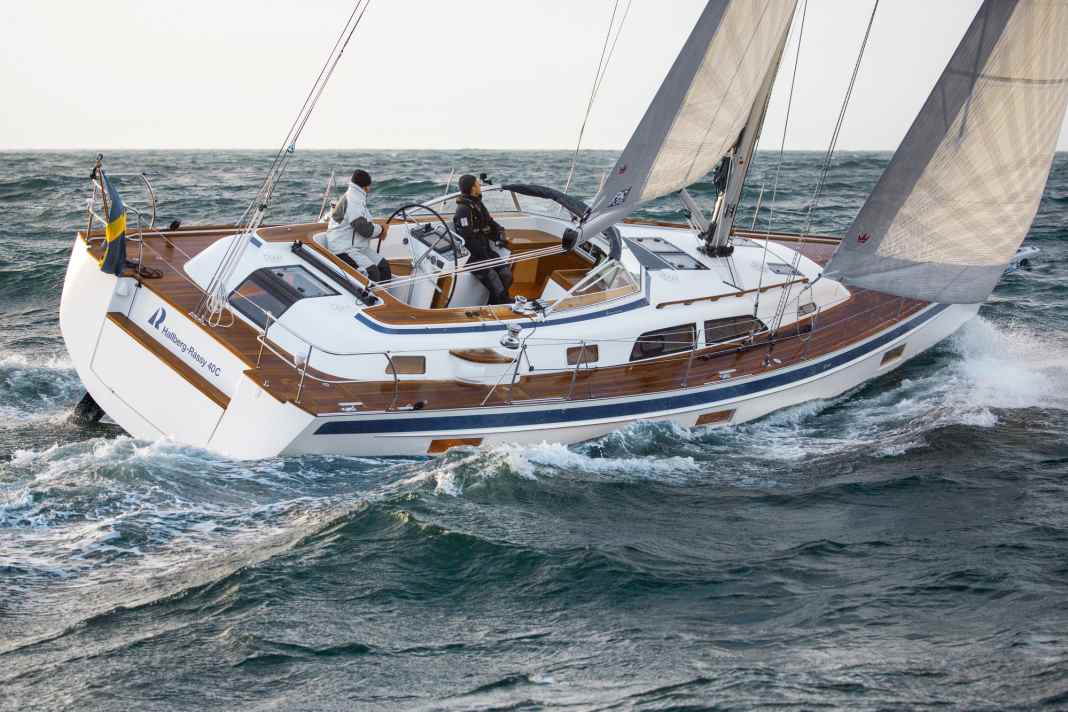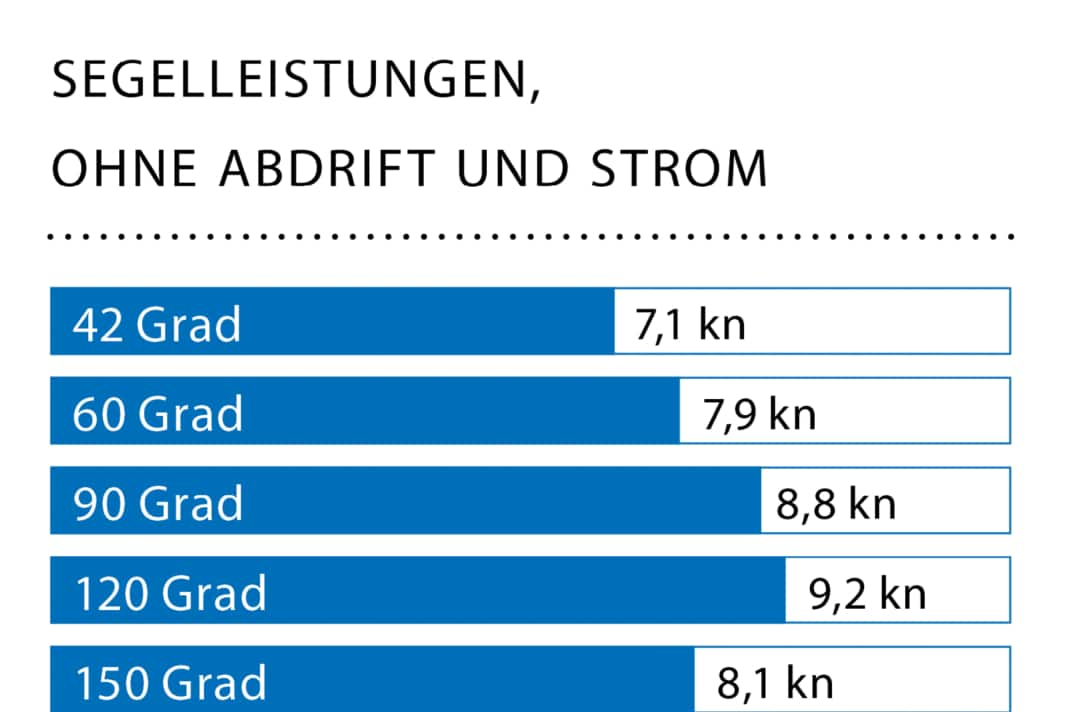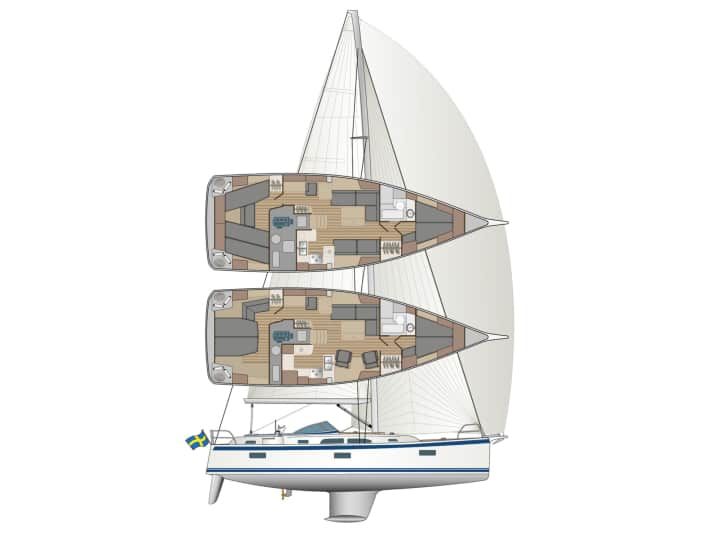Hallberg-Rassy 40C: Cruising tourer of impeccable quality in the YACHT test






It may not seem like the best of ideas to test a sailing yacht late in December and high up in Sweden - the likelihood of storms and snowfall is quite high. However, the current situation and upcoming events sometimes require unusual courses of action. And when the Hallberg-Rassy shipyard is testing a brand new model just before Christmas, the YACHT test editorial team is of course involved.
More from the shipyard:
- Used boat test Hallberg-Rassy 29: Solid ship, solid investment
- Used boat test: Hallberg-Rassy 312 - a lot of boat for the money
- Test Hallberg-Rassy 340: Agile and good-natured sailor - the ideal cruising yacht?
- Hallberg-Rassy 342: Popular used boat offers the usual quality
- Hallberg-Rassy 400: Close to the perfect cruising yacht
- The queen of cruising yachts: Hallberg-Rassy 69 on test
- With the drone through the shipyard: awesome video from Hallberg-Rassy
However, the forces of ice and darkness are exercising pleasing restraint for the Nordic test run. Although it is fresh and, with winds of around 20 knots, also draughty, a storm front that has passed through in advance has left behind an impressive swell of two to three metres in height out on the open sea. However, for a large, robust centre-cockpit yacht like the new Hallberg-Rassy 40C, the conditions are just right for a thorough test.
Germán Frers' design works its way through the choppy sea with noticeable power and energy. Sailing hard upwind against the high and steep waves is challenging, so it is better to let the Rassy run a little in these conditions with slightly chopped sheets. The Swede easily manages just under 8 knots speed over ground on a course of 60 degrees to the wind, and she enters the waves pleasantly smoothly.
The fact that the crew in the high centre cockpit also get a few splashes is probably less due to the design than to the harsh conditions and the sprayhood rolled up for the test.
The desire to tax
Steering the new HR over the powerful shafts is easy and simple. The rudder system, which works entirely with cardan shafts, provides the helmsman with sufficient feedback and good response behaviour to the large wheel. The Swede is easy to control at all times, even when heeling heavily in the gusts, thanks of course to the double rudder blades. This is particularly evident on the course back to the coast with the wind. Like a small sports boat, the eleven-tonne luxury cruiser can be steered wonderfully under pressure. This is not only a lot of fun on the wheel, but also ensures amazing performance. The daily record during the test was 12.6 knots in the surf, with wave support. For a touring boat of this orientation, size and weight, that's a real achievement.
Measurement results of the Hallberg-Rassy 40C






Determining the exact performance data is easier in the sheltered archipelago off Ellös. Here the boat tacked at an angle of 85 degrees in winds of between 15 and 18 knots and only a few waves, logging just over 7 knots of speed. These are also impressive results for a centre-cockpit yacht with basically little demand for proven performance. The high-quality laminate sails from Elvstrøm, which are attached to the test boat, are a great help. As standard, the boat is equipped with a set of simpler Dacron sails, also from Elvstrøm.
The perfectly matching furling mast from Seldén is also on the list of options, but is ordered in most cases. In combination with electric drives for all halyard and sheet winches as well as for the furlers, the sails can not only be furled and unfurled at the touch of a button, but in the case of the genoa they can also be hoisted tightly or furled thanks to Revo winches from Lewmar.
Sheeted as a simple six-fold jib, however, the mainsheet guide is too weak and requires a lot of strength to haul tight and caution when furling, especially in stronger winds. An additional winch for trimming the mainsail would be appropriate at this point, but is unfortunately only available as an extra and at extra cost.
The plus in volume
With an impressive width of 4.18 metres and a hull length of 12.30 metres, the new ship from Ellös is not only fuller than the boats of comparable competitors, but also has much more compact lines than her larger sister Hallberg-Rassy 44 (test in YACHT 3/2017), which is 1.40 metres longer but only just two centimetres wider. This allows the shipyard to build the centre cockpits of the two boats in exactly the same dimensions. The stern in particular has become even beefier on the new and smaller ship and is actually even wider than on the 44, by 24 centimetres.
Prices of the Hallberg-Rassy 40C
- Base price ex shipyard: 641,500 euros gross including 19% VAT.
- Standard equipment included: Engine, sheets, railing, navigation lights, battery, compass, cushions, galley/cooker, bilge pump, toilet, sailcloth, anchor/chain, fenders, mooring lines, fire extinguisher, electric cooler, holding tank with suction, antifouling paint, clear sailing handover
- Also included in the price: Bowsprit with anchor bracket, lead keel, fixed windscreen, teak grating on the cockpit floor, cockpit table
- General guarantee: 1 year
The shipyard uses the additional volume to create two large and deep stowage boxes in the stern, for example for the fenders and mooring lines. The tailgate at the stern, which is only available as an option, closes to half of the transom. The shipyard wants to save weight with a smaller platform and be able to dispense with an electric mechanism for opening and closing; a simple tackle pull is sufficient for the test ship. Meanwhile, the shipyard does not intend to offer a larger bathing platform as an option, such as on the HR 44.
As with all current models, Hallberg-Rassy also builds the hulls and decks of the new 40C centrally in the shipyard's own production facility in nearby Kungshamn. The structures are built as robust sandwich constructions with a foam core using the proven hand lay-up method. In the new ship, the shipyard has now for the first time raised part of the floor frames up to the hull-deck connection for reinforcement. This means that the craftsmen can largely dispense with the previously unavoidable half bulkheads when fitting out below deck, which opens up more scope for design options below deck.
More space on request
The galley is available in two sizes. In the extended, extremely spacious version, the galley is extended by more than half a metre aft. This gives the galley more work space and storage options. A dishwasher and an additional refrigerator can also be accommodated. If you choose the smaller standard galley, which still offers enough space and plenty of storage space, the volume between the galley and aft cabin is used to install a larger and deeper locker, which is accessible from the cockpit. Here, the customer ultimately has to decide and weigh up the trade-offs.
There are also extension options for the spacious aft owner's cabin. And here, too, the advantages of the extreme width at the stern are once again clearly evident: instead of the centrally positioned double bed, a side twin berth and an additional berth for single use can be installed. Hallberg-Rassy can lay exclusive claim to the alternative with up to three berths aft among the direct competition.
More space instead of a second bathroom
What also sets the Hallberg-Rassy 40C apart from the competition, however, is the lack of an option for a second bathroom. The Swede has just one, but particularly spacious bathroom in the bow with a separate shower area, plenty of storage space and the option of installing a washing machine. The previous Hallberg-Rassy 39 and 40 models also only had one toilet area. In this respect, the Swedes are sticking to the tried-and-tested concept and utilising the space in a different way.
This benefits the engine room, for example, which you can even crawl into a little. The four-cylinder built-in engine with 60 hp from Volvo Penta is installed inverted, i.e. behind the saildrive, a first for Hallberg-Rassy. This creates space for a generator, which then finds its place directly behind the companionway steps.
Technology fans will once again get their money's worth on the new Hallberg-Rassy ship. All installations are impeccably executed, perfectly labelled and easily accessible everywhere. The shipyard installs the on-board technology and cabling at the very end of the ship, in some cases even after the furniture. In this way, the yacht builders want to ensure that the components always remain easily accessible.
Hallberg-Rassy also focusses on ventilation. Numerous hatches, large customised superstructure windows that can be opened and several dorade vents ensure sufficient circulation in the ship. The doors of the lockers and storage compartments are also fitted with ventilation slots and, at the rear, some are fitted with beautifully laid stanchions in real wood.
Maintaining a good reputation
Describing the construction and finishing quality of yachts from Ellös is a bit like carrying water into the Rhine. Anyone who is interested in sailing boats knows the brand and the quality of its products. It is not without reason that the name Hallberg-Rassy has stood for the high quality of Scandinavian yacht building for decades. And with their new 40C, the Swedes are once again underpinning this long and hard-earned reputation.
YACHT review of the Hallberg-Rassy 40C
Fourth model of the latest generation Hallberg-Rassy with a wide stern and two rudder blades. The 40C showed excellent sailing characteristics in the test in high waves. The impeccable quality and first-class equipment explain the high price.
Design and concept
Modern construction
Robust and high-quality construction
Well-protected centre cockpit
Sailing performance and trim
Sails stiff and fast
Safe, easy handling
Weak mainsheet guide
Living and finishing quality
Cosy ambience below deck
First-class finishing quality
Pantry available in two sizes
Equipment and technology
Extensive basic equipment
High-quality add-on parts
No large bathing hatch feasible
The Hallberg-Rassy 40C in detail

Technical data of the Hallberg-Rassy 40C
- Design engineer: Germán Frers
- CE design category: A
- Torso length: 12,30 m
- Overall length (with bowsprit): 13,06 m
- Waterline length: 11,74 m
- Width: 4,18 m
- Draught/alternative: 1,92/1,60 m
- Theoretical torso speed: 8.3 kn
- Weight: 11,0 t
- Ballast/proportion: 3,65 t/33 %
- Mast height above waterline: 19,75 m
- Mainsail: 52,2 m²
- Furling genoa (110 %): 44,2 m²
- machine (Volvo P.): 44 kW/60 hp
- Fuel tank (plastic): 400 l
- Fresh water tank (plastic): 520 l
- Holding tank (plastic): 60 l
Hull and deck construction
GRP sandwich laminate with foam core, built by hand with vinyl ester and polyester resin. Full laminate in the keel and rudder shaft areas.
Shipyard
Hallberg Rassy Varvs AB, 47431 Ellös (Sweden); www.hallberg-rassy.com
Distribution
Hallberg-Rassy Deutschland GmbH, 23730 Neustadt; www.hallberg-rassy.de
The Hallberg-Rassy 40C at YACHT tv
The test was first published in 2020 and has been revised for this online version.

